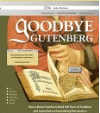| Another
Review at MyShelf.Com |
||||||||||||||
|
By Written and Designed by Valerie Kirschenbaum Goodbye Gutenberg is not only a book; it is an example of the future of writing. I’m going to back up a bit. It was about four years ago that I attended Summer Literary Semester in St. Petersburg, Russia (www.sumlitsem.org) where I took a class in something called hypertext. I was a computer neophyte—a non-geek of the first order. Before I took it, I double checked to be sure that that the instructor had planned his material to accommodate those of us with no tekky blood running through our veins. It was my introduction to—more or less—letting a reader read by her own design. The writer, of course, had some control over what that reader might experience once she had clicked a link, but it is the reader who chooses the direction using those little blue links, provocatively underlined to tempt readers to new territory. We were even introduced to a program that makes this kind of writing at least semi-automatic. Though Goodbye Gutenbergis a traditional book (that is a book printed on real paper and bound), it is influenced by Silicon Valley and the future. One sees—perhaps for the first time—the connection between brightly colored links and the illumination of old texts of vellum and gold-painted introductory caps. Not only that but writers are often multi-talented and rarely do those abilities coalesce into a single work. Kirschenbaum notes that many have flirted with “shaping words into images.” Milton Glaser transformed letters into icons. Herb Lubalin sculpted words into pictures. Known in some circles, these are hardly household names. The author says that those who were the most “passionate about the appearance of the words were not—and still are not—the writers.” Those who use words for content, however multi-talented they may be, generally do not think of combining their talents into a single work. Arguably, comic book writers are the exception, and “graphic novels” are a blooming genre—a portent, certainly—of more to come. Kirschenbaum points out that many artists use their layered abilities well. Some write music and lyrics and then sing their songs. Directors, who are certainly visual, write their own screenplays. However, Kirschenbaum searches in vain for what she calls a “designer writer” or “designer prose” of any great stature. To be sure, the web holds promise for those so inclined to challenge her premise. Very few are stocking their pages with plain text any more. Kirschenbaum’s Goodbye Gutenbergis an example of her yearning for “designer prose” that goes beyond a lovely coffee table book. It is 416 beautiful pages, luscious four color pictures influenced by beautiful books and writing of the past, an index that yearns to be read because the book is packed with such good “stuff,” flyleafs that could well be framed, and a dustcover so silky it asks to be stroked. A teacher, she tempts with subjects like “Color, Reading and the Brain” and touches cultures as if they were meant only to fire modern writers’ imaginations. Maya. Islam. China. Egypt. This book was meant for everyone, not just writers. Those who will be consumed by the sheer fun of it are historians, teachers, anthropologists, artists, feminists (no kidding!), and on and on. In other words, Kirschenbaum may go down in history—if history chooses to be just—as a woman of all seasons. You will not want to miss this book. Kirschenbaum truly “writes in color.” |
|
|||||||||||||
©
2005 MyShelf.com |
||||||||||||||
 Goodbye
Gutenberg
Goodbye
Gutenberg